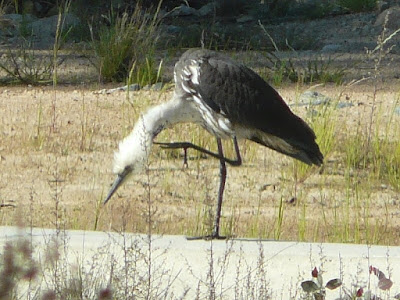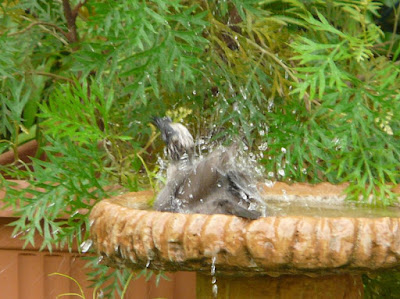A feather is a truly wonderful thing. Birds, the most numerous group of land vertebrates, owe their spectacular success to their feathers, which evolved from the scales of their dinosaur ancestors. The original function of these finely-divided scales was to provide insulation by trapping a layer of air around the owner's body (like the principle of double-glazed windows). In time they developed further to enable flight (one of only four times this has happened in the history of life on earth), and to form the basis of sometimes spectacular courtship displays. (And I have that in mind for a future blog post too.) Small wonder then that a considerable part of every bird's day is devoted to high-grade care and maintenance of its feathers.
I don't want to spend a lot of time on the feathers themselves, though it wouldn't be hard to do so, but I do need to show you the basic structure, so you can get a better idea of what the birds in the following photos are actually doing.
And every bird must spend a considerable amount of time every single day in feather maintenance, including 'rezipping' every feather. Here are just a few of many photos I could have chosen, in a wide range of different birds, showing the attention to detail associated with the daily preen. The first three clearly show a single feather being rezipped.
 |
| Black Swan Cygnus atratus, Pambula, south coast New South Wales. This bird is moulting its flight feathers, so is temporarily unable to fly. |
 |
| Eurasian Coot Fulica atra, Canberra, attending to its wing feathers. |
 |
| Yellow-billed Spoonbill Platalea flavipes, Jerrabomberra Wetlands, Canberra, also paying careful attention to its crucial flight feathers. |
 |
| Mistletoebird Dicaeum hirundinaceum, Milang, South Australia, conscientiously working on his secondary flight feathers. |
 |
| Blue-faced Honeyeater Entomyzon cyanotis, in a street tree in Griffith, NSW. |
 |
| Brown Pelican Pelecanus occidentalis, Puerto Ayora, Galápagos, low in a mangrove in the port. |
 |
| Little Raven Corvus mellori, Kosciuszko National Park, NSW. Again this bird was quite close to us, but engrossed its task. |
 |
| Spinifex Pigeons Geophaps plumifera, indulging in some group preening near Alice Springs. |
 |
| Male Australian Darter Anhinga novaehollandiae taking preening oil from the gland at the base of his tail, before anointing his feathers with it. |
 |
| These Southern Mealy Parrots (or Amazons) Amazona farinosa, here at Blanquillo Clay Lick in the Peruvian Amazon basin, are so named for their abundance of powder down, ‘mealy’ meaning ‘floury’. |
 |
| Pacific Heron Ardea pacifica, in Grenfell, NSW, scratching a part of her body which is inaccessible to her bill. The use of the middle (front) toe is clear. |
 |
| Olive-backed Oriole Oriolus sagittatus scratching, somewhat awkwardly, in a backyard tree in Nowra, NSW. |
 |
| A Golden-headed Cisticola Cisticola exilis which emerged from its reedbed habitat at the Jerrabomberra Wetlands in Canberra to have a good scratch. |
 |
| Austral Negrito Lessonia rufa, Argentinian Patagonia. She is bathing in a stream fed by a nearby glacier, at 50 degrees south, so staying cool is not her chief issue! |
 |
| May in Canberra isn't quite that cold, but this Eastern Rosella Platycercus eximius wasn't trying to escape the heat either. |
 |
| Red-rumped Parrot pair Psephotus haematonotus, Lake Cargelligo, central NSW. |
 |
| Crimson Chats Epthianura tricolor at Willie Rockhole, near the edge of the Great Sandy Desert, Western Australia. This hole, unsurprisingly, was attracting a regular parade of bathers. |
 |
| Young Grey Fantail Rhipidura albiscapa in palm leaf bath, Coffs Harbour Botanic Gardens, north coast of NSW. |
 |
| Male Golden Whistler Pachycephala pectoralis, Canberra. |
 |
| Silver-crowned Friarbird Philemon argenticeps in a Darwin back yard. |
 |
| Australian White Ibis Threskiornis molucca, bathing at a popular human swimming spot at Howard Springs, near Darwin. |
 |
| Double-barred Finches Stizoptera bichenovii and Chestnut-breasted Mannikin Lonchura castaneothorax on the same Darwin bath featured in the friarbird photo above. |
 |
| Eastern Spinebill Acanthorhynchus tenuirostris in a garden near Mount Clunie NP, far northern NSW. |
 |
| Metallic Starling Aplonis metallica at renowned bird lodge Kingfisher Park, near Julatten in northern Queensland. |
 |
| Australian Pelican Pelecanus conspicillatus vigorously splashing at Tidbinbilla Nature Reserve near Canberra. |
 |
| Sulphur-crested Cockatoo enjoying the rain. |
 |
| Crested Pigeon Ocyphaps lophotes making the most of the hose in our back yard. This is obviously fairly recently learned behaviour. |
 |
| House Sparrow Passer domesticus, deep in a dust bath in a village on the island of Anchao, southern Chile. |
 |
| Speckled Mousebirds Colius striatus crowding into a patch of dried mud to conduct their dusty ablutions on Mount Kenya. |
 |
| Black Vultures Coragyps atratus catching the early sun at Muyuna Lodge on the Amazon River, northern Peru. Even in the tropics nights and early mornings can be cool. |
 |
| Common Bronzewing Pigeon Phaps chalcoptera sunning on a big granite boulder in Namadgi NP south of Canberra. |
 |
| Macleay's Honeyeater Xanthotis macleayanus enjoying the popular sunning site at Kingfisher Park already mentioned. This bird was quite contorted. |
 |
| Red Wattlebird Anthochaera carunculata sunning in the garden below our balcony. This one really did look dead or dying for a while! |
 |
| Social Flycatchers Myiozetetes similis sunning on a log in southern Peruvian Amazonia. |
NEXT POSTING THURSDAY 14 APRIL
I
love to receive your comments and in future will be notifying you
personally by email when a new posting appears, if you'd like me to. All
current subscribers have been added to this mailing list and have
already been contacted. This will mean one email every three weeks at the current rate of posting. I promise never to use the list for any other purpose and will never share it.
Should you wish to be added to it, just send me an email at calochilus51@internode.on.net. You can ask to be removed from the list at any time,or could simply mark an email as Spam, so you won't see future ones.
Thank you!








2 comments:
A fascinating post Ian, well illustrated. I have seen many a magpie seemingly dead in my backyard. I will look more closely at preening birds now.
Thanks Kath. Apart from the intrinsic interest of understanding things better, I think there's something relaxing about watching birds preen so meticulously.
Post a Comment